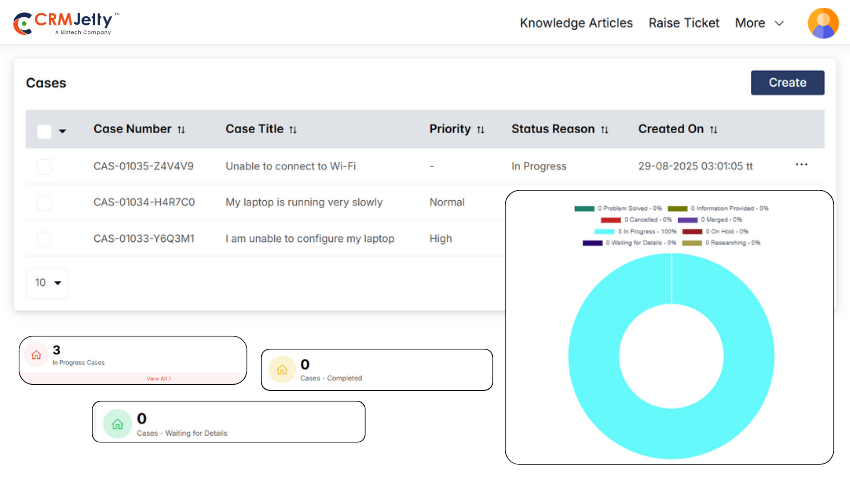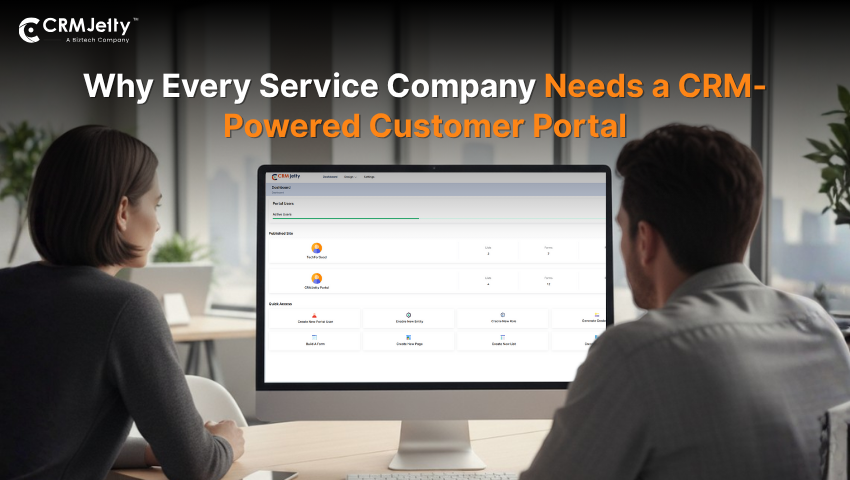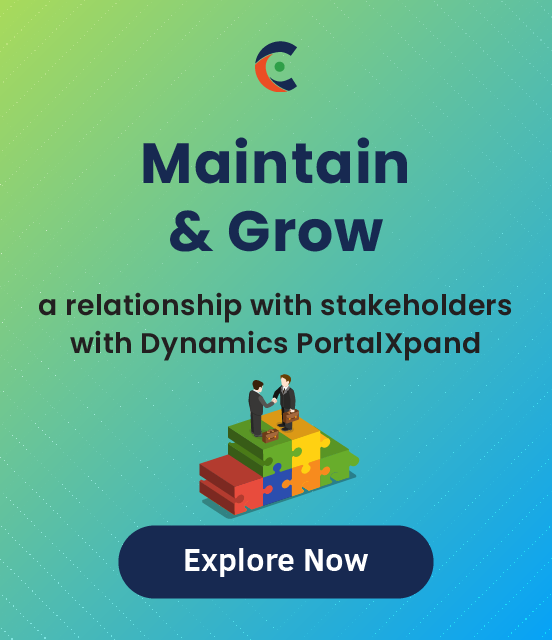We live in an age where everything is getting faster. Dinner is delivered in 30 minutes. Ride share arrives at your door in 5 minutes. And packages? They’re on your doorstep the same day. But your service delivery? Sadly, it is still stuck in the past.
Your customers are still calling the support team to check on the status of their appointments. Your team is resending the invoices via email… twice, sometimes three times. Your field technicians show up at the wrong address because your systems aren’t synced.
In a nutshell, your team is not at fault here, nor are they creating these bottlenecks. It’s the system they are using that’s forcing them to do the same work manually over and over, when automation should be doing the heavy lifting.
CRMJetty’s Dynamics 365 customer portal, tailored to your existing CRM setup, can fix the situation. Now, before we get into how that works, let’s talk about what’s actually going wrong in your service delivery right now, in detail!
The Pain Points Slowing Down Your Service Delivery
We’ve worked with service companies across a dozen industries. And trust us when we say that while the service delivery workflows look different for each company, the problems are always the same. For instance, customers cannot get basic information without making a call. Your team spends hours on tasks that should take minutes. And everyone’s frustrated because the tools aren’t keeping up.
Here’s where service companies most often struggle when they don’t have a customer portal in place.
Customers Have No Real-Time Visibility Without a Dynamics CRM Customer Portal
A customer calls your support team to ask about the status of their service request, saying, “Has my HVAC repair service request been approved?” Your representative logs into the CRM, checks the record, and confirms that it is still pending. A few hours later, the same customer calls again and speaks to a different representative, who gives the exact same answer. Nothing has changed, but your team has now spent additional time repeating information that already exists in your system.
The problem is that customers cannot view this information themselves. The data sits in your CRM, but without direct access, customers are forced to call, and your team spends valuable time responding to repetitive queries.
This is where a Dynamics customer portal for service companies delivers real value. By integrating CRMJetty’s Dynamics customer portal with your existing Dynamics 365 CRM system or Business Central, you can provide customers with real-time updates. They can log in to view up-to-date status for their cases, approvals, or appointments, without waiting for a callback.

To make the experience even more efficient, our customer portal’s global filter feature can further help your customers to refine information by date, service type, or region. So, instead of relying on phone conversations, they can locate the details they need within seconds.
What this results in is surprising! Your customers will feel more confident because they can access information at any time, your support team spends less time answering repetitive questions, and your business operations run more smoothly.
However, visibility is only one part of the problem. Even when customers can see the status of their requests, they still need reliable access to supporting documents. That is where the next bottleneck shows up.
Invoices and Documents Get Lost in Email Threads
Your finance team sends an invoice via email. The customer loses it, and then they email back asking for a copy. Your team re-sends it.
A week later, the same customer needs the invoice again. Another email, another manual send, and things are happening in the same loop! Multiply this by hundreds of customers, and your team is drowning in document requests that shouldn’t exist.
Service agreements get buried in email threads, receipts are saved under random file names, and important PDFs disappear into crowded inboxes. The information exists, but when no one can easily find it, delays and frustrations follow.
That’s where CRMJetty’s Dynamics CRM customer portal can help. Once you implement it, the portal offers centralized document access where customers can easily view, download, and manage their documents directly from the portal. This means you will no longer have to rely on manually resending documents or stay caught in endless email chains. Additionally, with real-time syncing between your CRM and the portal, both your team and your customers will always have access to the most up-to-date information and documents, eliminating delays.
You might be thinking, “What if my team or a customer can’t find a specific document in the portal?” Well, the good thing is that CRMJetty’s Dynamics customer portal can be configured to ensure that all documents are organized and easily accessible.
Moreover, the portal integrates with your Dynamics 365 CRM to provide direct access to customer-specific documents, ensuring that everything is tied to the correct account. Role-based access control can also be implemented to make sure sensitive documents are only accessible to authorized users, while others are available to the relevant parties. In short, no more time will be wasted searching through email inboxes. Everything will be right where it should be —at your fingertips, available in real time.
That being said, if your team is stuck in the “re-sending documents and answering the same questions,” it is time you automate it.
Take the first step toward improving your service delivery.
Field Teams and Customers Are Out of Sync
Missed appointments, wasted travel hours, and frustrated customers — all of this happens when your systems don’t talk to each other. The booking sits in one system, while the field team’s schedule lives in another, and both end up using outdated information.
With a self-managed appointment system built into CRMJetty’s Dynamics customer portal, you can put an end to that confusion. Using the CRMJetty portal, customers can book, reschedule, or cancel their appointments anytime, and every change instantly syncs back to your CRM. This means your field teams always have the latest updates, and reducing the risk of missed or mistimed visits.
Add to that, the role-wise redirection feature ensures each customer lands directly on their relevant booking dashboard after login, making the process faster and clearer.
Paired with workflow automation, confirmations and reminders go out automatically — keeping customers informed and field teams aligned without manual coordination.
At this point, it will be right to ask, “What happens if a customer reschedules at the last minute?” In such cases, CRMJetty’s Dynamics portal can be configured to send instant priority alerts to your field teams. It will ensure that they can adapt quickly, avoid wasting time while traveling, and focus on urgent tasks.
| Expert TipOver time, appointment history can reveal recurring patterns. For instance, if certain customers frequently reschedule or cancel, your team can proactively plan around these changes. This insight reduces scheduling conflicts and helps anticipate potential issues before they occur. |
Helpdesk Overloaded with Simple Requests
Password resets, address changes, profile edits — these small, repetitive requests can easily overwhelm support teams. While none of them are complex, they add up fast, eating into time that could be spent solving bigger customer issues.
The fix is simple: self-service profile management. With a Dynamics customer portal, users can handle these updates themselves — reset passwords, update contact details, or manage preferences instantly. Every change syncs back to the CRM automatically, keeping data accurate without manual intervention.
You can go a step further with custom widgets that create quick-action panels, such as “Update Profile” or “Reset Password.” These make routine tasks effortless, reducing the number of inbound support requests and freeing your helpdesk to focus on high-impact issues that actually need their expertise.

Revenue Opportunities Are Sitting in CRM Data Silos
When customer data sits in silos, your sales team can’t see the whole picture — who’s using which service, or who’s ready for an upgrade. The information exists inside your CRM, but without visibility, potential revenue slips through the cracks.
By integrating Dynamic Data Widgets into your customer portal, you can bring that hidden data to life. These widgets surface real-time insights, such as service usage, completion status, and upgrade eligibility, right on the dashboard — helping your sales team spot opportunities instantly.
You can even take it a step further with AI-powered suggestions leveraging your CRM’s intelligence to recommend relevant services or upgrades based on customer history and behavior.
| Expert TipUse clickable counter widgets on the dashboard to highlight real-time metrics such as “Services Completed This Year” or “Pending Upgrades.” When customers click on these counters, they can be redirected to relevant purchase pages. This creates a natural bridge from information to action, turning passive visits into potential sales without the need for cold calls. |
Now that we have covered the main breakdowns happening in service delivery, here is the moral of the story: manual processes and disconnected data are costing you time, money, and customer satisfaction. Each of the challenges we looked at has its own set of problems, but they all share the same root cause—your systems are not communicating with each other.
And that brings us to the “SOLUTION” that can solve this once and for all!
CRMJetty’s Dynamics Customer Portal (The Bridge Between Your CRM, Team, and Customers)
Many legacy portals act like basic login layers and lack deep CRM integration or workflow automation. And they definitely don’t solve the problems we just walked through.
CRMJetty’s Dynamics customer portal is different from all those generic solutions because it can connect everything. When you implement CRMJetty’s portal, your existing CRM communicates with the portal, and the portal communicates back with your CRM. Data flows both ways in real time, and what happens in one place instantly reflects in the other.
You may think, “What happens if a customer has a specific issue with their appointment or their data? Can they really resolve it without involving support?”
The answer is yes. CRMJetty’s portal is designed with self-service capabilities that allow customers to check the status of their requests, track changes, and even update their information on their own. This ultimately reduces the number of support calls for routine inquiries and gives your team the freedom to focus on more complex tasks.
Beyond self-service, CRMJetty’s Dynamics customer portal also gives you the flexibility to implement advanced features that directly enhance efficiency and security:
- Role-Based Access Control can be set up to define exactly who can access what. Customers only see their data, partners see theirs, and admins can manage access down to individual fields.
- With Workflow Automation and Email Triggers, you have the capability to send confirmations, reminders, and status updates automatically. Once the rules are defined, the system takes care of them on its own.
- Multisite Support inside the CRMJetty Dynamics customer portal lets you run portals for different business units or regions. While each site can carry its own branding and workflows, they can all be managed from one central admin console.
- Through Seamless Mobile Access, customers gain the ability to view invoices, book appointments, or reschedule services from any device, anywhere.
- With ISO 27001 & 9001 Certified Security, your business meets enterprise-grade compliance standards from the very beginning, ensuring data remains protected and customer trust remains intact.
The real strength of CRMJetty’s portal lies in how these capabilities work together once it is implemented. For example, a customer books an appointment through the portal. That booking syncs instantly with your CRM. Your field team sees it on their schedule without delay. A confirmation email is automatically sent, and a reminder is sent 24 hours before the appointment. If the customer reschedules, the update propagates across all connected systems in real time.
This is exactly what a properly integrated customer portal for service companies should deliver. By ensuring every update flows across systems in real time, it eliminates manual effort, reduces errors, and keeps your teams and customers aligned at every step.
Get started in weeks, not months. Discuss a pilot deployment of CRMJetty’s customer portal with our experts.
What Changes When You Deploy CRMJetty Dynamics Customer Portal?
Before companies deploy a CRM customer portal, they face high support volumes due to repetitive queries. Manual updates consume admin time. Customers feel frustrated because they cannot access basic information. Approvals take days because everything is routed through email.
Once CRMJetty’s Dynamics portal is implemented, you can start to see changes very quickly. It can reduce inbound queries to support teams by more than 50% because when customers can check their own status, they stop calling to ask about it.
Approvals can also move faster. Customers can track progress themselves. They see when something is pending and when it is approved, and they no longer need to email for updates.
Your field teams can implement real-time data into their workflows instead of relying on outdated spreadsheets. As a result, missed appointments drop, drive time is optimized, and customer satisfaction improves because technicians show up when they are supposed to.
On the revenue side, your team can unlock opportunities through intelligent suggestions. The portal surfaces insights that reveal upsell and cross-sell options your sales team might not have spotted otherwise.
What changes immediately is time. With a portal in place, your team gets hours back every week, customer satisfaction scores improve because people are not waiting on hold for basic information, and your operational costs drop because you no longer need to add more support staff to handle volume that should never exist in the first place.
| Expert Tip:Track KPIs like portal logins, self-resolved tickets, and appointment reschedules to measure ROI within the first 90 days. These metrics will highlight exactly where the portal is creating value and where you may need to adjust. |
These results are visible across industries, each with its own unique workflows. Let’s look at where this approach works in practice.
Industries Where This Actually Works
No matter the industry, service companies often struggle with the same issues. Sure, the workflows may look different, but the underlying problems, like disconnected communication and CRM data silos, are too common. And that’s where CRMJetty’s Dynamics customer portal can step in to help.
- Nonprofits: Managing donors and volunteers is often a back-and-forth of emails and spreadsheets. By implementing a portal, you can give donors transparency into their contributions and volunteers the ability to manage their own schedules. This will not only save time but also build trust, leading to more engagement.
- Educational institutions: Parents call the school for updates on grades, attendance, and schedules, often multiple times a week. With a student and parent portal, families can check that information on their own, reducing calls to the office and making everyone’s job a little easier.
- Insurance companies: Claim status calls are a huge drain on resources. So, implementing a claims portal can let policyholders track the progress of their claims without picking up the phone. This can reduce support workload and give customers the real-time answers they need.
- Healthcare providers: Patients often call to schedule, reschedule, or confirm appointments. With an appointment scheduling portal, they can manage everything online. This capability frees up time for your staff and gives patients a better, more streamlined experience.
- Manufacturing businesses: Customers typically want to know the status of their orders. Instead of making calls to your team, a real-time order-tracking portal can provide them with the transparency they need, reducing follow-up questions and streamlining your processes.
- Real estate firms: The back-and-forth on property documents and transaction statuses can slow down deals. With a client portal, all the key documents and information can be made available in one place, speeding up the process and making it easier to close deals.
- IT services companies: Support ticket systems can get bogged down with status updates. By implementing a ticket portal that lets customers track the progress of their issues, your team can focus on resolving more complex problems, while customers stay informed without needing constant updates.
Across all industries, while workflows differ, the fundamental solution remains the same. CRMJetty Dynamics’ customer portal solution is capable of providing your customers with access to their own information, allowing them to manage routine tasks independently. It can also free up your team to focus on tasks that truly require human expertise.
We’ve covered what it does and who it works for. But what actually sets CRMJetty customer portal apart from the dozens of other solutions out there?
What Makes CRMJetty’s Customer Portal Different From Generic Solutions
Most portal solutions lock you into a single CRM, but CRMJetty’s Dynamics customer portal gives you the flexibility to use what works best for your business. Whether you’re using Dynamics 365 or Business Central, the portal integrates seamlessly with your existing CRM, without disrupting your current processes. You won’t have to migrate your data or switch systems, so the transition will be smooth and efficient.
Now you might be thinking, “What if we decide to switch CRMs in the future? Will the portal still work?” Believe it or not, the beauty of CRMJetty’s portal is its flexibility. Since it can integrate via APIs, you’re never locked into one CRM provider. If you switch to Salesforce or another CRM down the road, the portal can easily adapt, keeping your data and processes in sync, no matter which system you choose.
Scalability is another key advantage of this solution. You can start simple, maybe with basic document access and appointment booking features. As your needs evolve, you can expand functionality to include automated workflows, AI-powered suggestions, and more. Put simply, the portal grows with your business!
And when it comes to customization, it’s a breeze with CRMJetty’s no-code solution. Your marketing team can personalize the portal’s look and feel using just a drag-and-drop widget builder.
On the security side, everything is built-in, and not bolted on. With role-based access control, you can ensure that only the right people see the correct data. Activity logs track key user actions (logins, downloads, updates), giving you complete visibility into portal usage, so you can catch any potential security issues before they become a problem.
Lastly, everything is auditable. When compliance teams need proof of controlled access, they can generate reports in just a few clicks. Similarly, if executives need insights into how the portal is being used, the system provides those reports with ease, ensuring both transparency and compliance.
Transform Your Service Delivery with Automation
Your customers expect quick access to their information, and our Dynamics customer portal helps make that happen. Once the portal is in place, your team won’t get stuck answering the same questions over and over or re-sending documents. With automation and data centralized in one place, your customers can handle these tasks on their own, freeing up your team to focus on the more complex things that truly require their expertise.
The companies excelling in service delivery are already automating routine tasks and offering self-service options. And with CRMJetty’s Dynamics customer portal, you can do the same without adding extra staff. By giving your team more time back, you’ll reduce the friction that slows down both your employees and your customers.
But implementing the solution is just the first step. Once the portal is live, getting customers to adopt it is key. Luckily, CRMJetty can also make that easy with simple guides and support, whether through training, helpful emails, or in-portal announcements.
When your customers see how quickly they can solve their own problems with the portal, they’ll realize it’s a faster, more convenient option than picking up the phone or sending an email. In short, CRMJetty empowers them to self-serve, leading to greater satisfaction, a more productive team, and a positive impact on your business overall.
So, are you ready to switch to automated workflows and let your team and customers work smarter with real-time self-service?
Take the next step toward streamlining your operations.
All product and company names are trademarks™, registered® or copyright© trademarks of their respective holders. Use of them does not imply any affiliation with or endorsement by them.







